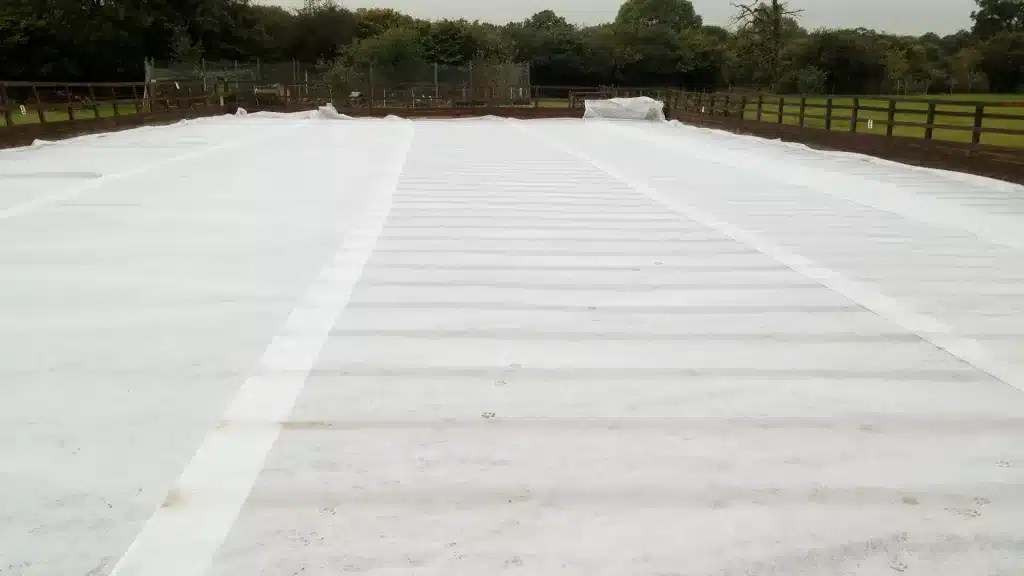+86-159 9860 6917
info@geofantex.com
geofantex@gmail.com
+86-400-8266163-44899
Non-woven geotextile fabric is a vital component in civil engineering projects, offering numerous benefits and applications. This synthetic fabric, composed of mechanically bonded fibers, provides filtration, separation, reinforcement, and drainage capabilities.
It finds extensive use in road construction, landfills, erosion control, and drainage systems. Its high strength, excellent filtration properties, and resistance to UV degradation make it a durable and reliable choice. Proper installation techniques ensure optimal performance, making non-woven geotextile fabric an essential element in ensuring the longevity and stability of infrastructure projects.

What is non-woven geotextile fabric?
Non-woven geotextile fabric is a synthetic material made from polypropylene or polyester fibers that are mechanically bonded together through a process such as needle-punching or heat-bonding. It possesses several key characteristics:
- Porosity: Non-woven geotextiles have high porosity, allowing water to pass through while retaining soil particles.
- Strength: Despite being lightweight, they offer excellent tensile strength, tear resistance, and puncture resistance.
- Durability: These fabrics are resistant to biological degradation, chemicals, and UV radiation, ensuring long-term performance.
- Flexibility: Non-woven geotextiles conform well to irregular surfaces and are easy to install.
These fabrics find wide application in various civil engineering and construction projects, including:
- Drainage: They are used to facilitate drainage in roads, retaining walls, and landfills by preventing soil erosion and promoting water flow.
- Filtration: Geotextiles act as filters to separate fine soil particles from drainage materials, preventing clogging.
- Reinforcement: They reinforce weak soils, improving stability in applications such as embankments, slopes, and erosion control.
- Separation: Geotextiles create a barrier between different soil layers, preventing mixing and maintaining structural integrity.
The benefits of non-woven geotextile fabric include cost-effectiveness, environmental sustainability, and versatility. They reduce construction time, minimize maintenance needs, and enhance the overall performance and lifespan of civil engineering projects.
What are the functions of non-woven geotextile fabric?
Non-woven geotextile fabric serves several essential functions in various applications and industries:
- Filtration: Geotextiles act as filters, allowing water to pass through while preventing soil particles from migrating. This helps in preventing soil erosion and maintaining the stability of structures.
- Drainage: They facilitate water drainage by allowing water to flow through the fabric while retaining soil particles. This is crucial in drainage systems, road construction, and landfill applications.
- Separation: Geotextiles provide separation between different soil layers, preventing mixing and maintaining the integrity of engineered structures. This is vital in road construction, railway tracks, and other civil engineering projects.
- Reinforcement: In some applications, geotextiles are used to reinforce soil, providing additional strength and stability to structures such as retaining walls, embankments, and slopes.
- Protection: Geotextiles offer protection to geomembranes, liners, and other vulnerable materials by acting as a cushioning layer and preventing punctures or abrasions.
- Erosion Control: They help in controlling soil erosion by stabilizing slopes, riverbanks, and shorelines, thereby protecting the environment and infrastructure.
Overall, non-woven geotextile fabric plays a crucial role in civil engineering, construction, environmental protection, and other industries by providing filtration, drainage, separation, reinforcement, protection, and erosion control functionalities.
Where is non-woven geotextile fabric used?
Non-woven geotextile fabric is widely used in various applications and industries due to its versatile properties. Here are some common uses:
Construction and Civil Engineering:
- Roads and Highways: Used as a separator to prevent the mixing of subgrade and aggregate layers, enhancing the stability and lifespan of the road.
- Railways: Provides separation and stabilization, ensuring the longevity and performance of railway tracks.
- Embankments: Used to reinforce embankments and prevent erosion, ensuring structural stability.
Water Management:
- Drainage Systems: Facilitates water flow and prevents soil clogging in drainage systems, improving efficiency and longevity.
- Erosion Control: Used in areas prone to erosion, such as riverbanks and shorelines, to prevent soil loss and maintain landscape integrity.
- Retaining Walls: Provides filtration and drainage behind retaining walls, preventing water buildup and structural damage.
Landfills and Waste Management:
- Liners and Caps: Used in landfill liners and caps to prevent contamination of groundwater by providing a barrier against leachate.
- Leachate Collection Systems: Enhances the effectiveness of leachate collection systems by allowing water to pass through while blocking soil and waste particles.
Agriculture:
- Soil Stabilization: Helps in stabilizing soil in agricultural fields, preventing erosion and improving soil quality.
- Drainage Improvement: Enhances drainage in fields, preventing waterlogging and promoting healthy crop growth.
Environmental Protection:
- Sediment Control: Used in construction sites to control sediment runoff and protect surrounding environments.
- Wetland Restoration: Assists in the restoration of wetlands by providing support and stability to the soil.
What are the advantages of using non-woven geotextile fabric?
Non-woven geotextile fabric offers several benefits and advantages in comparison to other materials for various applications:
Filtration and Separation:
- Soil Stabilization: Non-woven geotextiles prevent the intermixing of different soil layers, enhancing the stability and lifespan of structures.
- Drainage: They allow water to pass through while retaining soil particles, preventing soil erosion and promoting efficient drainage.
Durability:
- Resistance to Biological and Chemical Degradation: These fabrics are resistant to mold, mildew, and chemical reactions, ensuring long-term performance in diverse environments.
- High Tensile Strength: They can withstand significant stress and strain without tearing, making them suitable for heavy-duty applications.
Ease of Installation:
- Flexible and Lightweight: Non-woven geotextiles are easy to handle and install, reducing labor costs and time.
- Adaptability: They can be used in a variety of applications, including road construction, erosion control, and landfills.
Cost-Effectiveness:
- Reduced Maintenance Costs: Their durability and effectiveness in soil stabilization and drainage reduce the need for frequent maintenance and repairs.
- Lower Initial Investment: Non-woven geotextiles are generally more affordable than woven alternatives and other traditional materials.
Environmental Benefits:
- Enhanced Sustainability: By preventing soil erosion and promoting efficient water drainage, non-woven geotextiles contribute to environmental conservation.
- Recyclability: Many non-woven geotextiles are made from recyclable materials, reducing their environmental footprint.



Get Free Sample
We’ll respond as soon as possible(within 12 hours)





















